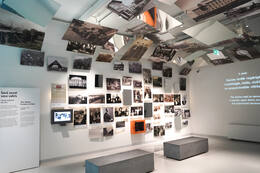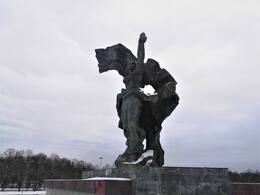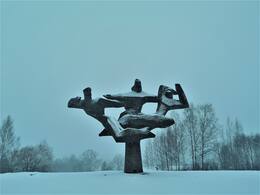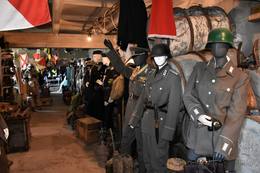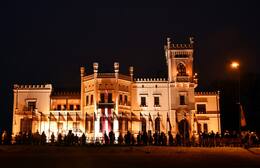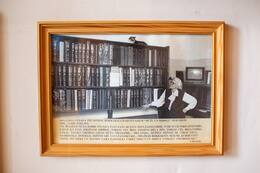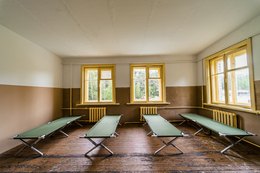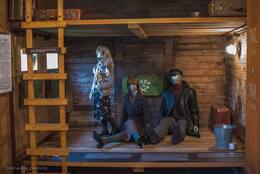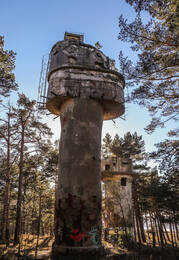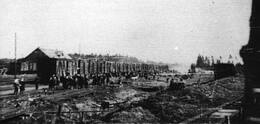Totalitarizmas II WW2, IV Sovietų okupacija
Totalitarizmas (iš lot. totalis 'visa apimantis'; angl. Totalitarism, vok. Totalitarismus, prancūzų totalitarisme, rusų totalitarizmas) – politinė santvarka, kurioje valstybė valdoma be visuomenės dalyvavimo totalitarizme, priimami nepasitarus su visuomenės dauguma; Svarbiausia socialinė, ekonominė ir politinė veikla totalitariniame režime yra kontroliuojama valstybės. Tai tokia diktatūros rūšis, kai valdžia riboja žmones visose srityse. Diktatūroje valdžia priklauso nedideliam žmonių ratui ar net vienam asmeniui. Būdingi bruožai: valstybės valdžia sutelkta siauros grupės – klikos – rankose; opozicijos slopinimas, visuotinis teroras kaip valstybės valdymo instrumentas, visų gyvenimo sferų pajungimas valstybės interesams ir vyraujančiai ideologijai; nuolat mobilizuota visuomenė, naudojanti lyderystės kultą, masinius judėjimus, propagandą ir kt.; agresyvi, ekspansinė užsienio politika; visiškai kontroliuoti viešąjį gyvenimą.
Totalitarinių režimų laikotarpis Latvijoje chronologiškai skirstomas į 3 etapus: 1) pirmoji SSRS okupacija nuo 1940 m. birželio 17 d. iki 1941 m. liepos mėn.; 2) nacistinės Vokietijos okupacija nuo 1941 m. liepos mėn. iki 1944 m. rudens (Kuržemėje iki 1945 m. gegužės mėn.); 3) antrosios sovietinės okupacijos laikotarpis nuo 1944 m. rudens iki Stalino mirties 1953 m.
Totalitarizmo terminą sugalvojo italų antifašistinis publicistas Džovanis Amendola. 1925 m. šią sąvoką priėmė Italijos ministras pirmininkas ir diktatorius Benito Mussolini (Benito Amilcare Andrea Mussolini), o fašistai pradėjo jį laikyti savo politinės sistemos pavadinimu. „Totalitarizmo“ idėją iš italų fašistų perėmė vokiečių dešinieji intelektualai, tokie kaip filosofas Carlas Schmittas, liberalizmo ir liberalios valstybės kritikas.
Akademinėje bendruomenėje vyksta diskusijos, kurie režimai gali būti laikomi totalitariniais. Visuotinai sutariama, kad XX a. režimai nacistinėje Vokietijoje (1934–1945), SSRS valdant J. Stalinui (1929–1953), Kinijoje valdant Mao Dzedongui (1949–1976), Korėjos Liaudies Demokratinėje Respublikoje (Šiaurės Korėja), valdant Kimo dinastijai (1934–1945 m.). –1979) tokiomis laikomos nuomonės apie kitas šalis ar kitus laikotarpius nurodytose šalyse.
Daugiau informacijos šaltinių
Daina Bleyer. Totalitarizmas. Nacionalinė enciklopedija. https://enciklopedija.lv/skirklis/51186
Totalitarizmas. Vikipedija. https://lv.wikipedia.org/wiki/Totalit%C4%81risms
Susijusi laiko juosta
Susijusios vietos
Latvijos okupacijos muziejus
Muziejuje eksponuojama Latvijos istorija nuo 1940 iki 1991 m., nacistinės Vokietijos ir Sovietų Sąjungos okupacijos laikotarpiu. „Ateities namai“ – tai žinomo Amerikos latvių architekto Gunāro Birkertaus suprojektuoto Okupacijos muziejaus rekonstrukcijos ir išplėtimo projektas, taip pat nauja muziejaus ekspozicija. Ekspoziciją „Čekos istorija Latvijoje“ sukūrė Okupacijos muziejus, ji yra buvusiame SSRS Valstybės saugumo komiteto (KGB) pastate „Kampiniame name“. Latvijos okupacijos muziejus buvo įkurtas 1993 m. Jis pasakoja ilgai slėptą Latvijos valstybės, tautos ir žemės likimo istoriją dviejų užsienio totalitarinių valstybių okupacijos laikotarpiu nuo 1940 iki 1991 m. 2020 m. pabaigoje muziejuje buvo daugiau nei 70 000 įvairių istorinių eksponatų (dokumentų, nuotraukų, rašytinių, žodinių ir daiktinių įrodymų, daiktų ir atminimo dovanų). Muziejaus specialistai įrašė daugiau nei 2400 vaizdo įrašų, todėl tai viena didžiausių okupacijos kolekcijų Europoje. Latvijoje, Lietuvoje ir Estijoje klostęsi įvykiai aiškiai parodo, ką tautoms teko ištverti valdant dviem totalitariniams režimams.
Pergalės parkas
Įsikūręs Rygoje, Pārdaugavoje, netoli Latvijos nacionalinės bibliotekos.
Pergalės parkas yra vienas didžiausių ir prieštaringiausiai vertinamų parkų Latvijoje. Jis užima 36,7 hektaro teritoriją, kurioje sukurtas monumentalus ansamblis „Sovietų Latvijos ir Rygos išvaduotojams nuo vokiečių fašistinių užpuolikų“, šlovinantis sovietų okupacinę valdžią. Pastatytas XVII a. įtvirtinimų vietoje, tai buvo paskutinė žinoma viešų egzekucijų vieta Latvijoje.
XX amžiaus pradžioje buvusios Kobronos tvirtovės teritorijoje buvo įkurtas kraštovaizdžio parkas. Jis skirtas Rusijos imperatoriui Petrui I, kurio armija 1710 m. užėmė Rygą. Įkūrus Latvijos valstybę, teritorijoje buvo suplanuotas ambicingas projektas – Pergalės parkas. Jis buvo sumanytas kaip Nepriklausomybės karo didvyrių pagerbimo vieta, Latvijos valstybės didybės ir pasitikėjimo savimi simbolis. Parkas, pastatytas už visuomenės aukas, buvo skirtas svarbiems renginiams, tačiau Antrasis pasaulinis karas sutrukdė šiam planui.
Sovietų okupacijos metu parko teritorija tapo 7 vokiečių armijos karininkų egzekucijos vieta. Tai buvo reikšmingas įvykis, nes 1985 m. buvo atidarytas didžiausias Baltijos šalyse sovietų režimą ir jo armiją šlovinantis objektas.
Iki 2022 m. rugpjūčio 23 d. (išardytas) buvo galima apžiūrėti monumentalų ansamblį, kuris reprezentavo vyraujančias paminklų statybos tendencijas Sovietų Sąjungoje. Erdvi parko teritorija puikiai tinka pasivaikščiojimams ir aktyviam poilsiui.
Laisvės kovotojų paminklas
Įsikūręs Tukums, Mālkalns, Jelgavas g. 15A.
Paminklas buvo atidengtas 1975 m., siekiant pabrėžti Raudonosios armijos nuopelnus Antrojo pasaulinio karo metu. Jis tarnavo kaip sovietinės ideologijos ir propagandos priemonė, simboliškai sustiprinanti okupacinio režimo buvimą Latvijoje ir kurianti sovietinio režimo kaip „išvaduotojų“ mitą. Paminklo autorius – skulptorius, kilęs iš Tukumo Arta Dumpė.
Po Vokietijos kapituliacijos 1945 m. gegužės 8 d. Raudonoji armija Kuržemę laikė priešo užkariauta teritorija, o ne išlaisvinta SSRS dalimi. Kuržemės gyventojai buvo priešai, o jų turtas – karo trofėjais. Represinė valdžia ir armija pradėjo „Kuržemės valymą“. 16–60 metų vyrai buvo sulaikomi, registruojami ir tikrinami. Pavojingumo požiūriu Kuržemės gyventojai – vyrai – buvo prilyginti kapituliavusios Vokietijos kariškiams. Prasidėjo Raudonosios armijos atlaidumas ir nusikaltimų banga – žmogžudystės, išžaginimai, plėšimai, areštai ir „žmonių dingimai“. Vienintelis ginkluotas pasipriešinimas kilo iš nacionalinių partizanų grupių. Sovietų valdžia sukūrė naikintojų batalionus, taip pat ir Tukumo rajone, kad būtų pašalintas bet koks pasipriešinimas. Smurto ir teroro banga pasiekė piką 1949 m., kai visoje Latvijoje vyko gyventojų deportacijos.
Paminklą galima pamatyti ir šiandien. Jo simbolinė reikšmė buvo interpretuojama įvairiai – tai mūšio scena arba motina, laikanti sūnus, kovojančius priešingose pusėse. Paminklas pastatytas ant kalvos, nuo kurios atsiveria įspūdingas vaizdas.
Privati karinė kolekcija Mundigcieme
Privati karinė kolekcija Mundigcieme. Aivaras Ormanis ne vienerius metus kolekcionuoja istorinius objektus – karines uniformas, uniformas, kamufliažas, ryšio priemones, buities daiktus, apsaugos priemones iš skirtingų laikotarpių ir šalių, siekiančias Antrojo pasaulinio karo, sovietų kariuomenės ir nepriklausomos Latvijos atkūrimo laikų.
Kolekcija šiuo metu nėra gerai prižiūrima, o eksponatai saugomi buvusiame kolūkio tvarte.
Alūksnės muziejus
Alūksnės muziejus įsikūręs nacionalinės reikšmės architektūros paminkle – neogotikinėje Alūksnės Naujojoje pilyje, pastatytoje XIX a. pabaigoje. Muziejuje veikia paroda „Totalitarinio režimo aukų memorialinis kambarys“, kurioje pasakojama apie Alūksnės savivaldybės gyventojų likimus Sibire ir Tolimuosiuose Rytuose, o laikotarpis nuo priešistorės iki šių dienų susitinka Alūksnės istorijos ekspozicijoje „Amžių šventė“. Joje yra atskiras skyrius, skirtas 7-ojo Siguldos pėstininkų pulko indėliui į kariuomenę, kultūrą ir visuomenės gyvenimą. 7-ojo Siguldos pėstininkų pulko formavimas prasidėjo 1919 m. birželio 20 d. Naukšėnų dvare. Iš pradžių iš Šiaurės Latvijos brigados rezervinio bataliono buvo suformuota 22 karininkų ir 1580 kareivių kovinė grupė, pavadinta Dankersų divizija. Ji buvo įtraukta į 3-iojo Jelgavos pulko 2-ąjį batalioną. Rugpjūčio 23 d., padidėjus kuopų skaičiui, jis tapo 7-ojo Siguldos pėstininkų pulko dalimi. Dalyvavęs mūšiuose prieš Bermontą, 1920 m. sausio 5 d. pulkas buvo perkeltas į Latgalos frontą kovoti su bolševikais. Pasirašius taikos sutartį su Sovietų Rusija, pulkas saugojo rytinę Latvijos sieną. Latvijos nepriklausomybės kare žuvo daugiau nei 200 pulko karių, o 85 buvo apdovanoti Lačplėšio karo ordinu. 1921 m. 7-asis Siguldos pėstininkų pulkas buvo dislokuotas Alūksnėje. Pulko štabas buvo įsikūręs Alūksnės naujojoje pilyje. Po Antrojo pasaulinio karo pilį perėmė sovietų saugumo institucijos. Nuo šeštojo dešimtmečio pabaigos pilyje buvo įsikūrusios įvairios kultūros įstaigos: Vykdomojo komiteto Kultūros ir kinematografijos skyrius, pionierių namai, biblioteka, kino teatras ir muziejus.
Melanijos Vanagos ir Sibiro kasyklos muziejus
Melanijos Vanagos muziejus įsikūręs Amatos kaimo mokykloje, Cėsių savivaldybėje. Muziejuje eksponuojama medžiaga apie rašytojos ir kultūros istorikės Melanijos Vanagos gyvenimą, literatūrinę veiklą, šeimą ir likimą: vaizdo medžiaga apie Sibirą ir ten gyvenančius tremtinius latvius bei Sibiro žeminė, nukelianti lankytojus į rašytojos tremties vietą Tiuchteco rajone, Krasnojarsko srityje. Žeminės išvaizda ir išplanavimas sukuria realistinį gyvenimo toli nuo namų vaizdą. Eminėje eksponuojami unikalūs istoriniai daiktai, atvežti iš Tiuchteto muziejaus: beržo tošies indas, vadinamas „tuesok“, molinis puodelis, vadinamas „krynka“, ir žibalinė lempa. Muziejuje rodomi vaizdo interviu su politiškai represuotais savivaldybės asmenimis ir 18 personažų iš Melanijos Vanagos knygos „Staiga nusikaltėlė: šešiolika metų Sibire“. Muziejaus virtuali paroda „BŪK SAVIMI!“. (http://esipats.lv) pasakojama apie penkių deportuotų vaikų ir jų tėvų, kuriuos sovietų valdžia neteisingai apkaltino „tėvynės išdavyste“, patirtį.
Sovietų armijos karinė bazė Paviluostoje – aktyvaus poilsio centras
Sovietmečiu čia buvo dislokuotas pasienio apsaugos dalinys, už kelių kilometrų miške buvo įsikūrę kiti sovietų armijos daliniai – ryšių karininkai ir žemė-oras raketų bazė. Atkūrus nepriklausomybę, čia buvo dislokuota Latvijos kariuomenė.
Buvusi sovietinės armijos karinė bazė dabar yra poilsio, laisvalaikio ir stovyklavimo centras – asmeniniam tobulėjimui, sąveikaujant su gamta ir aplinkiniais žmonėmis.
Poilsio ir apgyvendinimo vieta tiek turistinėms grupėms, tiek šeimoms. Kambariai, dušai, WC, laužavietės, erdvi erdvė pramogoms, gamtos garsai. Rezervuokite iš anksto telefonu +371 26314505.
Trėmimams naudotas galvijų vagonas – muziejus Skrundos geležinkelio stotyje
1941 m. birželio ir 1949 m. kovo mėn. trėmimams atminti Skrundos geležinkelio stotyje pastatytas atminimo akmuo ir keturašis vagonas, kuris taip pat tarnauja kaip trėmimams skirtas muziejus. Tai pirmasis vagono tipo muziejus Latvijoje, kuriame nuolat eksponuojamos iš Skrundos stoties ištremtų žmonių nuotraukos, laiškai, atsiminimai, dokumentai ir įvairūs daiktai. Skrundos stotis buvo tremtinių surinkimo vieta ir viena iš trijų regiono stočių, į kurią buvo atvežti žmonės iš Skrundos ir Kuldygos apylinkių. 1941 m. iš čia į Krasnojarsko kraštą Sibire buvo ištremta pirmojo atkurtos Latvijos Respublikos prezidento Gunčio Ulmanio šeima.
Deportacijų pagalba sovietai susidorojo su nacionalinių partizanų šalininkais ir tuo pačiu metu baugino likusius kaimo gyventojus, versdami juos stoti į kolūkius.
Karosta, Liepojos karinis uostas (ekskursija)
Karosta yra didžiausia istorinė karinė teritorija Baltijos šalyse ir užima beveik trečdalį visos Liepojos teritorijos. Karosta – unikalus karinių ir įtvirtinimų pastatų kompleksas Baltijos jūros pakrantėje, turintis ypatingą reikšmę Latvijos ir pasaulio istorijoje bei architektūroje. Karostoje yra tokie karinio paveldo objektai kaip Šiaurinis molas ir fortai, Redanas, Karostos kalėjimas, Karostos vandens bokštas, Šv. Nikolajaus stačiatikių Jūros katedra, Oskaro Kalpako tiltas ir kiti.
Paviluosto vietos istorijos muziejaus ekspozicija
Paviluostos kraštotyros muziejuje veikianti paroda, pavadinta „Paviluosta, uždara teritorija“, pasakoja apie kasdienį gyvenimą Paviluostos mieste sovietinės okupacijos metu; konkrečiai apie vykdomąją valdžią, pasienio zoną, žvejų kolūkį, kultūrinę ir socialinę veiklą. Be nuolatinės ekspozicijos, yra interaktyvi ir emociškai turtinga skaitmeninė ekspozicija dviem kalbomis bei audiovizualinė instaliacija, kurioje rodomas filmas apie Paviluostą.
Muziejuje taip pat atidaryta nauja paroda pavadinimu „Paviluostos auksiniai smėlio grūdeliai“. Skaitmeninėje instaliacijoje pristatomi seni įvykiai, Paviluostos įkūrimo istorija ir svarbiausi įvykiai nuo 1918 m. iki šių dienų. Karinis paveldas yra pagrindinis Nepriklausomybės karo skyriaus, kuriame pasakojama apie Latvijos laisvės kovotojus ir sovietinės okupacijos laikotarpį, akcentas.
Stendės geležinkelio stotis siaurojo geležinkelio tinkle ir atminimo akmuo tremtims
Geležinkelio linija Ventspilis–Mazirbė, taip pat Stendės–Dundagos pratęsimas iki Mazirbės su atšaka iki Pitragės buvo skirti tik strateginėms karinėms reikmėms. Šių linijų statybos metu ir vėliau iš regiono buvo evakuoti visi civiliai gyventojai. Pagrindinė karinių geležinkelių užduotis Irbės sąsiaurio rajone buvo aprūpinti Vokietijos armijos pakrantės gynybos pozicijas pabūklais ir amunicija.
Šie tik kariniams tikslams skirti kariniai geležinkeliai taip pat sujungė tris svarbiausius švyturius, esančius Ovišuose, Mikeltornyje ir Šlīterėje.
Nepaisant to, keleivių pervežimas buvo vykdomas jau Pirmojo pasaulinio karo metais.
Stendės geležinkelio stotyje yra atminimo akmuo (1989 m.) 1941 ir 1949 m. deportuotiems latviams.
1919 m. spalio 30 d. Stendės geležinkelio stotį užėmė Bermonto kariuomenė. Lapkričio 17 d. Latvijos armijos kareiviai, vadovaujami K. Šnēbergo, puolė stotį, nuvarydami vežimą su ginklais, karo medžiagomis ir grūdais. Už šiuos mūšius ordino ordinu buvo apdovanoti 6 kareiviai: K. Bumovskis (1891–1976), P. Strautiņš (1883–1969), R. Plotnieks (1891–1965), E. Jansons (1894–1977).
Susijusi istorija
Prie Skrundos stoties 1949 metais slapta nufotografuotas tremties ešelonas
1949 m. kovo 25 d. Skrundos mokinys Elmaras Heniņš matė, kaip buvo išvežti jo klasės draugai. Jis pasiėmė fotoaparatą ir užlipo ant netoliese esančios kalvos pušyno, kad užfiksuotų, kas vyksta, vėliau nuotraukas paslėpė.
Kolkos pakrančių apsaugos apžvalgos bokštas
Paskutinėse Kolkos rago pušyse pasislėpęs pasieniečių bokštas, kuriame sovietmečiu nuolat buvo pasieniečių postas, o šalia esantis nedidelis mūrinis pastatas dabar apleistas ir griūvantis.
Dzelzkalnų mūšis Žūrių girioje 1946 02 23
1945/46 m. Žalvario grupė 2011 metų žiemą praleido Žūrių girioje prie Dzelzkalnio, kur buvo pastatyti keli bunkeriai. Čia gyveno apie 40 partizanų. 1946 02 23 stovyklą apsupo SSRS vidaus reikalų kariuomenė ir vyko įnirtingos kautynės.
Kabilės užėmimas 1945–1946 m. sandūroje
Viena ryškiausių pokario ginkluoto pasipriešinimo Kuržemėje apraiškų buvo Kabilės užėmimas per 1945 m. Kalėdas ir po to įvykęs mūšis prie Āpuzniekų namų 1946 m. 2019 m. sausio 1 d.
Pēteris Čevers - nacionalinis partizanas ir partizanų grupės vadas
Pēteris Čevera - nacionalinis partizanas ir tautinių partizanų grupės vadas
Buvusio legiono leitenanto - čekų agento Arvīdo Gailīčio vaidmuo likviduojant Pēterio Čeverso grupuotę
Kapitonas Pēteris Čeversas ir dar septyni partizanai buvo sugauti 1950 metų lapkričio 1 dieną Engurės miško masyve, kur visai atsitiktinai netoliese buvo įsikūrusi netikra partizanų grupė, vadovaujama buvusio legiono leitenanto Arvīdo Gailīčio (agento-kovotojo slapyvardis „Grosbergs“). Jame buvo Latvijos TSR VDM operatyvininkai ir agentai-kovotojai, kurie apsimetė „miško broliais“.
JAV CŽV desantininkas Leonidas Zariņš – „netinkamas verbuoti“ čekai
Leonidas Zariņš buvo užverbuotas CŽV agentu JAV ir 1953 metais lėktuvu iš Vokietijos kirto SSRS sieną ir parašiutu nusileido netoli Aučės. Deja, vienas iš kontaktų, su kuriais jis turėjo susisiekti, pasirodė esąs dvigubas agentas ir Leonidas netrukus buvo suimtas. Jis atsisakė bendradarbiauti su čekistais ir be teismo buvo sušaudytas 1954 m.






